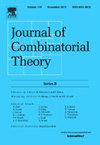The next case of Andrásfai's conjecture
IF 1.2
1区 数学
Q1 MATHEMATICS
引用次数: 0
Abstract
Let denote the maximum number of edges in a triangle-free graph on n vertices which contains no independent sets larger than s. The behaviour of was first studied by Andrásfai, who conjectured that for this function is determined by appropriately chosen blow-ups of so called Andrásfai graphs. Moreover, he proved for and in earlier work we obtained for . Here we make the next step in the quest to settle Andrásfai's conjecture by proving for .
Andrásfai猜想的下一个例子
设ex(n,s)表示无三角形图在n个顶点上的最大边数,其中不包含大于s的独立集。Andrásfai首先研究了ex(n,s)的行为,他推测对于s>;n/3,该函数由适当选择的所谓Andrásfai图的放大决定。此外,他证明了对于s/n∈[2/5,1/2],ex(n,s)=n2−4ns+5s2,在之前的工作中,我们得到了对于s/n∈[3/8,2/5],ex(n,s)=3n2−15ns+20s2。在这里,我们通过证明s/n∈[4/11,3/8]的ex(n,s)=6n2−32ns+44s2来解决Andrásfai猜想的下一步。
本文章由计算机程序翻译,如有差异,请以英文原文为准。
求助全文
约1分钟内获得全文
求助全文
来源期刊
CiteScore
2.70
自引率
14.30%
发文量
99
审稿时长
6-12 weeks
期刊介绍:
The Journal of Combinatorial Theory publishes original mathematical research dealing with theoretical and physical aspects of the study of finite and discrete structures in all branches of science. Series B is concerned primarily with graph theory and matroid theory and is a valuable tool for mathematicians and computer scientists.

 求助内容:
求助内容: 应助结果提醒方式:
应助结果提醒方式:


